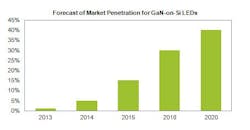IMAGE: GaN-on-silicon LEDs are expected to reach 40% market share by 2020. The figure shows the GaN-on-Si LED market share outlook in terms of revenue for the packaged LED market. (Image credit: IHS iSuppli)
Englewood, CO--According to a new report from IHS (NYSE: IHS) iSuppli, the penetration of gallium nitride-on-silicon (GaN-on-Si) wafers into the light-emitting diode (LED) market is forecast to increase at a compound annual growth rate (CAGR) of 69% from 2013 to 2020, by which time they will account for 40% of all GaN LEDs manufactured.
In 2013, 95% of GaN LEDs will be manufactured on sapphire wafers, while only 1% will be manufactured on silicon wafers. The growth in the manufacturing of GaN-on-Si LEDs between 2013 and 2020 will take market share from both sapphire and silicon-carbide (SiC) wafers.
"Manufacturing large ingots made from sapphire is difficult, whereas silicon wafers are available from 8 inches up to 12 inches and are generally cheaper and more abundant," said Dkins Cho, senior analyst for lighting and LEDs at IHS. "There is a large pre-existing industry for silicon-based manufacturing that is leveraged to create economies of scale and reduce the cost of an LED."
Repurposing manufacturing facilities to accommodate the shift toward GaN-on-Si LEDs is generally accepted to require minimal investment. Companies that previously manufactured CMOS semiconductors already own legacy 8-inch CMOS fabrication units that can be converted for LED production with a small modification. These companies already have in-house expertise and technology associated with silicon-based processes.
"Many of the CMOS semiconductor manufacturers already have excellent inspection tools, unlike traditional LED companies," Cho said. "This could help increase their process yield through in-situ monitoring. However, it is unlikely the repurposing will happen overnight; instead we forecast a shift during the coming years."
SOURCE: IHS iSuppli; http://www.isuppli.com/Semiconductor-Value-Chain/News/Pages/GaN-on-Silicon-LEDs-Forecast-to-Increase-Market-Share-to-40Percent-by-2020.aspx
